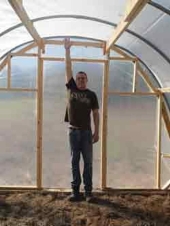
 23
23




 7
7




“Uncertainty is an uncomfortable position. But certainty is an absurd one.”
― Voltaire
 13
13




 12
12




“Uncertainty is an uncomfortable position. But certainty is an absurd one.”
― Voltaire
 14
14




 6
6




Jt Lamb wrote:
Historically, such as in the massive fires in Wisconsin in the late 1800's, entire forests went up, along with towns/communities, and whole families suffocated in their cellars & basements. Fire at that scale might be better avoided altogether ... and advance knowledge of what's coming at you is better from a prevention vs cure viewpoint.
“Uncertainty is an uncomfortable position. But certainty is an absurd one.”
― Voltaire
 12
12




If there is one thing the Wizard of Oz has taught me, it is not to trust school teachers on bicycles.
 11
11




John F Dean wrote:I know nothing about forest fires. I would be concerned about both oxygen and building a giant oven for myself. But, I do see great value in what you have done. First there is value in the root cellar aspect. Then, there is the fact that you have constructed an area that is more safe for equipment and other property you cannot remove from your site. Finally, if you cannot evacuate, you have created a safer place for your family. I am impressed.
“Uncertainty is an uncomfortable position. But certainty is an absurd one.”
― Voltaire
My fault for not being clear. I had intended for my comments to be toward the original post. Yes, you made it clear from the start you were building a basement.
That's what I figured, John. I just wanted to make there was no confusion between what I built and the OP's intentions.
 4
4




If there is one thing the Wizard of Oz has taught me, it is not to trust school teachers on bicycles.
 8
8




John F Dean wrote:Hi Michael,
You are approaching a great point. In psychology there us a saying that “ the best predictor of future behavior is past behavior.” I live in a forested region that has good rainfall and has never seen significant forest fires. Recent events in the west indicate that I may not be able to rely on past climate behavior. I need to revise my evacuation planning.
“Uncertainty is an uncomfortable position. But certainty is an absurd one.”
― Voltaire
 10
10




Country oriented nerd with primary interests in alternate energy in particular solar. Dabble in gardening, trees, cob, soil building and a host of others.
 2
2




C. Letellier wrote:...it had 3 doors. Entry, hanging canvas and the cellar door. Having dealt with flat to sloped doors the ideal would be a straight up and down door with a ledge/step going up at least one before going down so snow melt didn't get in and so shoveling the door off was minimal effort.
'What we do now echoes in eternity.' Marcus Aurelius
How Permies Works Dr. Redhawk's Epic Soil Series
 2
2




 5
5




 7
7




 9
9




 7
7




 11
11




 5
5




Josephine, Forest Witch
 5
5




 4
4




 4
4




 1
1




 8
8




Visit Redhawk's soil series: https://permies.com/wiki/redhawk-soil
How permies.com works: https://permies.com/wiki/34193/permies-works-links-threads
 8
8




 4
4










 4
4




Josephine, Forest Witch
 6
6




Wow, at that size, I immediately pictured an outdoor canning kitchen - you can tell what's in *my* dreams!It's 13 x 32 so truly huge. Because her husband is an electrician it is wired with lights, plugs, and an exhaust fan. I just have to plug it in with a strong extension cord. I'm going to put right next to an electrical plug I had installed on my power post.
Visit Redhawk's soil series: https://permies.com/wiki/redhawk-soil
How permies.com works: https://permies.com/wiki/34193/permies-works-links-threads
 1
1




 2
2




 1
1




 6
6




 6
6




Best luck: satisfaction
Greatest curse, greed
 3
3




 ?
?
 6
6




Best luck: satisfaction
Greatest curse, greed
 1
1




 8
8




 5
5




JayGee




Chi Monger wrote:
And someone, I thot, asked if they could achieve an above-ground cool room, like a root cellar…
 6
6




Luke Bryan wrote:
Chi Monger wrote:
And someone, I thot, asked if they could achieve an above-ground cool room, like a root cellar…
What is the general temperature range of a root cellar - and does an underground room somewhat replace a refrigerator without all the energy requirements?

|
Heroic work plunger man. Please allow me to introduce you to this tiny ad:
The new purple deck of permaculture playing cards
https://www.kickstarter.com/projects/paulwheaton/garden-cards
|






